
How a tide clock works ?
Tide clocks were invented by the British over 200 years ago.
As well as being useful the clock is now an aesthetic object, and goes with any decor! But this original device may raise a few questions : how does tide clock work ? Where a tide clock works ? Is a tidal clock precise ?
To make the functioning of our creations clear to you, you will find herebelow, in a few words and on video, the answers to all these questions.
You are invited to view our quick, simple video that explains in 3 parts how a tide clock works.
PLAY THE VIDEOA tide clock, what is it for?
Before we explain in details the functioning of a tide clock, it is essential to remind its utility. This kind of wall clock, as you probably understood, does not show the time but the tide, and more precisely the time remaining before low tide and high tide. A tide clock is a useful device which allows you to know in the twinkle of an eye if the tide is going down or up in your port or surf spot.
After this quick explanation of the utility of a tide indicator, it is now time to explain to you how a tide clock works.
How a tide clock works ?
First of all, it is important to outline that these clocks do not function exactly like usual clocks. Indeed, our tide clocks are assembled with a silent and specific quartz mechanism. Why a specific movement ? Simply because tide indicators do not go round the clock in 24h, like a typical clock, but in 12 hours 25 minutes and 14 seconds. This length of time may seem strange to you but it actually corresponds to the average time between 2 high tides and 2 low tides, in zones where tides are mostly regular.
You need to know that when you receive your tide clock, it will not be set. As there are many ports and beaches around the world, our crew cannot set it in our workshop.
To make a tidal clock work, all you need to do is insert a AA battery and set your clock on the local tide times for the location of your choice. To do so, we invite you to visit our page : how to set a tide clock.
Once your tide indicator is ready to function, all you have to do is follow the position of the clock hand to know the state of the tide. For your information, the tide clock hand goes clockwise. You wish to learn more on how to read the face of a tide clock ? Find out here how to read a tide clock.
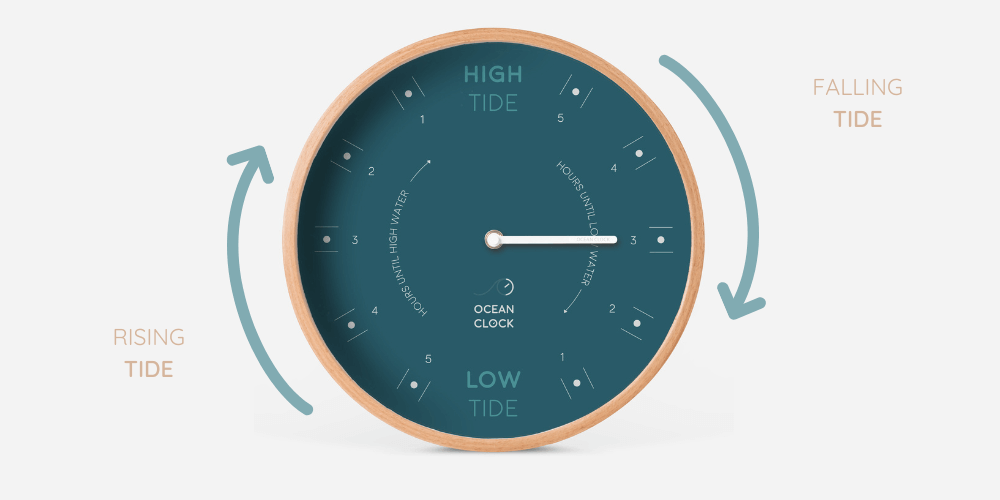
You now know how does tide clock work. You still have some questions about it ? Let us answer them then : does a tide clock work everywhere ?
![]()
Where tide clocks work ?
You like our creations and wonder if Ocean Clock tide clocks will function where you are ?
By principle, a tide clock works everywhere, no need to be living on the seaside! Indeed, a simple battery is necessary to make it work. However, the clock is not adapted to all oceans and seas over the Earth. This clock shows tide times for places where tides are regular. This tide indicator is only adapted to semidiurnal tides. This involves two high tides and two low tides of relatively similar magnitudes that is to say 24h50mn.
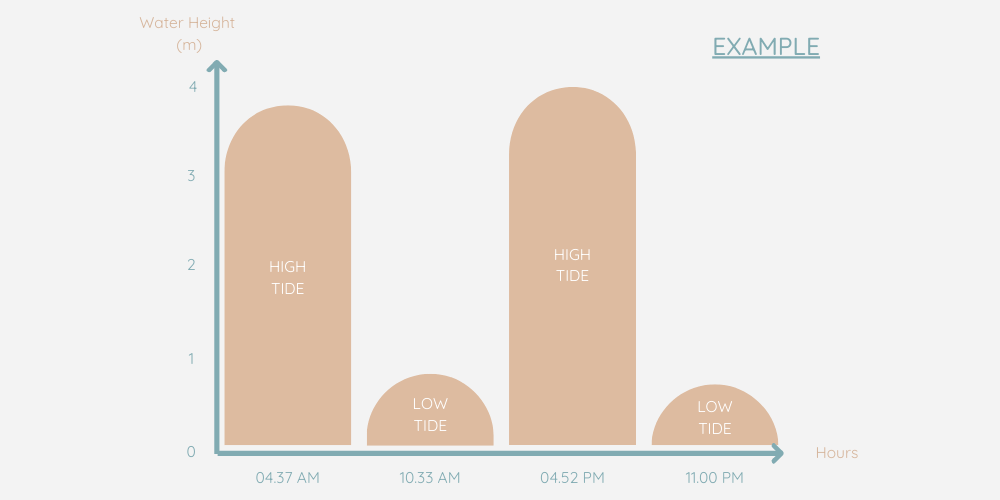
To sum it up, check this video to find out where tide clocks work.
We have listed on the map below the geographical zones where tides are semidiurnal and thus adapted to tide clocks. As shown on this map, the tide clock is most suited for a usage on the coasts of the Atlantic ocean.
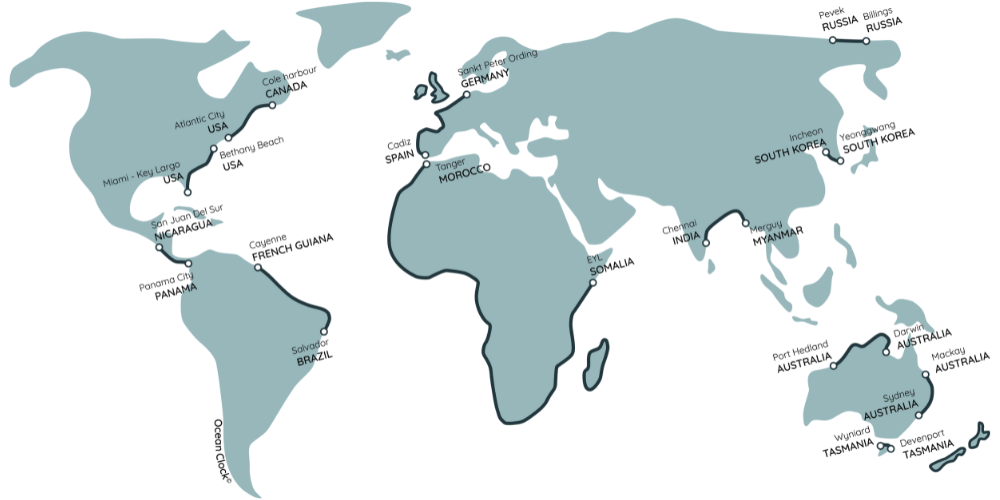
At European level, our tide clocks will indicate you the state of the tide on the Atlantic coast from the south of Spain to the border between Germany and Denmark as well as for most coasts of the United Kingdom and Ireland. Other corners of the world are also suited for the use of tide clocks. Indeed, our tide clocks work on almost the entire American east coast, on most of the African continent's coastline, on some Australian beaches and also on all New Zealand's coasts.
To know if a tide clock is adapted to your location, consult the tides chart website which will tell you the water levels of high and low tides. Thanks to its graph, you will instantly know if tides close to your location are semidiurnal.
See below the comparison between a location where the tide clock works and a location where tides are not adapted to this type of clock.
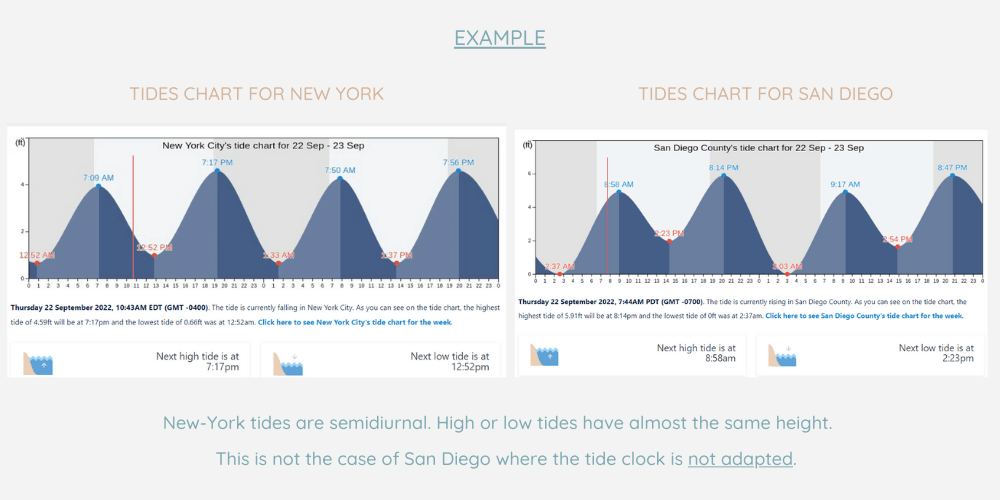
However, the tide clock is not adapted to the sea such as the Mediterranean and Baltic seas as they have very low water level variations, or no variations at all for some of them. The tide clock will not be accurate on those coasts !
![]()
Are tide clocks accurate ?
Several centuries ago, tide indicators were developed with mathematical calculations based on lunar days. What is a lunar day ? It corresponds to the time that the Moon takes to go round the Earth, that is to say 24 hours 50 minutes. How come we refer to lunar days and not solar days ? Simply because the Moon plays an important role on tides formation. It is mostly the gravitational forces of the Moon onto the Earth which create more or less strong tides. Scientists realised that during a lunar day, two high tides as well as two low tides get formed in most oceans.
Basically, we get a high tide and a low tide in 12h25mn.
You are wondering how precise a tide clock is ? During a lunar month (29 days), the tide clock is relatively precise according to the true state of the tide !
However, 12h25mn being the average time between two high tides or low tides, it can happen that some days the tide clock undergoes slight intervals during a tide cycle. It is normal to notice, generally during the first and last quarters of the moon (that is to say 3 or 4 days a month), differences of more than an hour with the actual time of the tide.
However, the clock automatically readjusts in the following cycles, therefore these intervals are just temporary.
Those slight intervals may happen locally when natural elements or weather conditions (violent winds, position of the Sun and Moon in relation to the Earth, equinoxes...) come and affect tides. Therefore, tide cycle may be less regular than usual. For instance, an incoming tide can last 6h40mn while an outgoing tide may last 5h45mn, and so obviously they do not last the same length of time.
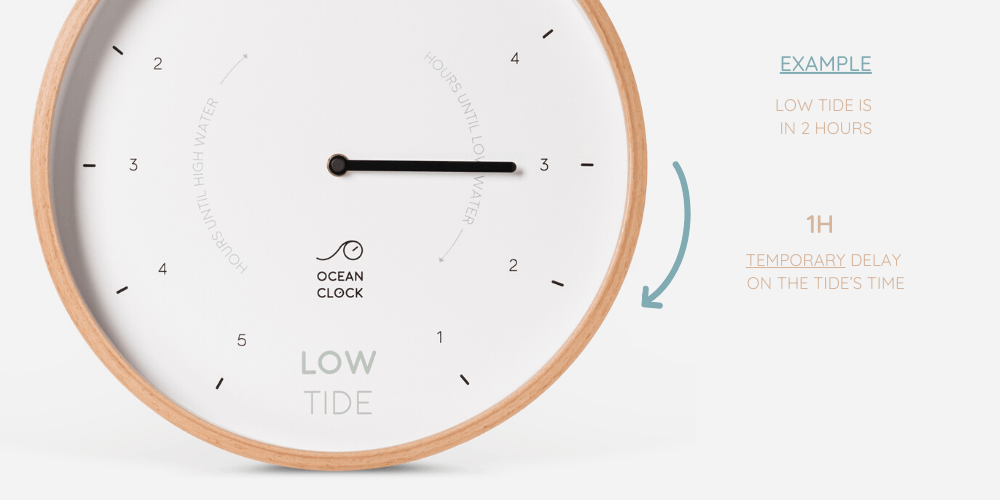
If you notice intervals in comparison with tide calendars, you must not adjust the clock as you will disrupt the functioning of its movement. You just need to reset it twice a year after equinox periods (we invite you to read our article on equinoxes), periods which trigger strong tides, that is to say on the first day of Spring and first day of Autumn. If intervals keep happening, do not hesitate to contact us either by phone or via our contact form.
These tide clocks do not claim to be as accurate as tide calendars or connected tide watch. They mostly aim at giving you the state of the tide so you know the best time to leave your home and get into the water.
For your information, tide clocks are not adapted to seafaring. Some water activities require more precise and complete tools that provide current information and precisions about tidal coefficients and water levels, which all are essential to seafaring.
 (7).png)
Does the tide clock’s customisation impact its functioning?
To make your tide clock a unique object, we offer you the possibility to customise it. Note that only the clock’s metal hand can be customised with the inscription of your choice. The clocks’ faces were carefully thought out and designed to make you travel through our world. That is why they cannot be modified.
However, you are free to inscribe whatever you want on this tide’s clock singular hand (limited to 19 characters). This customisation option is a little aesthetic extra which has no impact on its functioning.
You may customise your tide clock with the inscription HOSSEGOR or with any other location, but it obviously will not make your clock indicate the tide state of the town name you engraved on it. Whether it is a date, a few fun words, the title of your favourite song or the name of a beach, you will have to set the clock yourself to the tide time of the port of your choice.
Our tide clocks work where you live ? Then, do not hesitate to have a look at our collection of tide clocks, worldwide shipping available.
How toread a tide clock ?
Play the videoHow do youset your clock
Read more